george mark audio technologies First Overture DAC/Preamp
| george mark audio technologies First Overture DAC/Preamp |
|
|
|
Key Kim |
|
November 2004 |
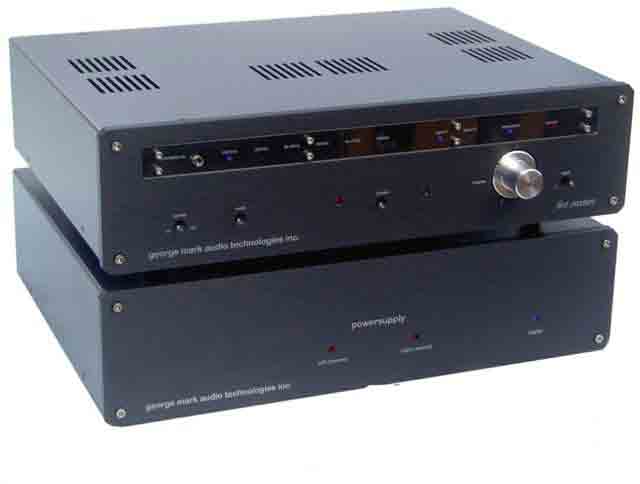
I was first introduced to George Bischoff at the 2003 International CES in Las Vegas. His George Mark Audio Technologies First Overture DAC/Pre-amplifier proved music to my ears played through the Nearfield Acoustics Pipe Dream loudspeakers (which he also co-designed) along with VAC’s newest amplifiers. I was struck by the overall naturalness, realism and soundstage capability of this setup. I was hungry to know more about this product.
George Mark Audio Technologies is the brainchild of George Bischoff and Mark Moschella; both pioneers in high-end audio who established standards that are used by many audio designs to date. Both were also co-designers of the Nearfield Acoustics Pipedream loudspeakers. Considering Bischoff’s knowledge of electrical circuitry and past successes, there’s no wonder he’s considered the brainiac of the duo. Bischoff was co-designer, along with audio guru Mark Porzilli, behind the Melos Electronics fame of yesteryear. There, the team of Porzilli and Bischoff boasted a couple of audiophile firsts: Melos was the first company to produce a tubed CD player for the audiophile market. Additionally, the SHA-1 tube headphone amplifier was also a first of its kind leading the way to a new level of appreciation for a set of headphones. Bischoff, a connoisseur of music, classical being his forte, is also a season ticket holder at The Met in New York City (I’m told he can also play a mean Banjo too). True to his roots, after he and Moschella departed from Nearfield Acoustics, First Overture was born. After two years of intense R&D, Bischoff and Moschella hit upon a special combination using their respective skills, advanced technologies matched to REAL VALUE to produce this, their very first DAC and preamplifier built under their new company George Mark Audio.
Thanks to Clement Perry, I was given the opportunity to do a review of the First Overture in my personal audio rig because he too has this unit sounding quite extraordinary in his analogue rig (I assume this also may lead to a follow-up review). I was eager to do the full review and hope to recreate the impressions I experienced at the 2003 CES.
The First Overture arrived in two double-boxed corrugated cartons. It’s quite stout for a DAC/preamp; both the control unit and separate power supply are substantial. While unpacking the unit, I was immediately impressed by its look and feel. The First Overture’s construction quality is of very high standard, chassis and controls are well laid out, simple yet elegant. They feature superior fit and finish of machined steel, aluminum, and copper. The volume control is crafted of brushed aluminum that gives it a smooth feel and distinguished look against the chassis’ black palette. The separate power supply, this one being exactly the same size as the main control chassis (extra rack space is a must!), is said to also provide excellent RFI and EMI rejection as well. Connecting the two chassis is achieved via two supplied cables with RS232 connectors.
A front panel mounted input selector provides easy selection, utilizing toggle switches: On/Off, Mute and a very rare Phase toggle switch (reverses absolute phase). The LED identifies the position of the Phase, displaying green for 0 degrees or “red” for 180 degrees. There is a toggle selector that flips from Input 1 and 2 also located on the front panel. Input 1 serves as the additional analog input for that possible Phono-stage or that high-rez SACD/DVD-A player you might own. The Input 2 selector is the First Overture’s digital input and thus completes its DAC/pre qualifications. Located right above the input selector is the up-sampling switch. With the flip of this switch the First Overture upsamples standard 16/44 redbook CDs to 132.2 Khz. I did a number of long listening evaluations with and without upsampling, and most of the time I preferred upsampling. To me, there was better detail resolution and smoother overall sound in the upsampling mode.
The rear of the First Overture supports both RCA and XLR digital inputs and an RCA input for another source such as a phono-stage. For those of you using modified DVD players without coax digital outputs will be happy to know this DAC has a Toslink input as well. According to Bischoff, the input selection is performed automatically by sensing the signal from the active input. A quartz crystal oscillator re-clocks the digital signal and purportedly eliminates all jitter.
The digital to analog decoder features 24 bit/192 kHz capability and upsamples lower standards up to 192 kHz. The analog stage consists of pure triode, true balanced, Class A, zero feedback, employing four 6922 (6DJ8) vacuum tubes. The First Overture is designed to drive any power amplifier directly from its outputs. Gain is user adjustable thanks to internal DIP switches designed to match the requirements of any power amplifier. The First Overture incorporates two dual mono-differential amplifiers and two low impedance differential output followers. I believe that power supply is one of the most important areas in any high-end product—especially digital.
Actually, when I first saw the First Overture, I was intrigued by this obviously overbuilt section. I discovered shortly thereafter this high performance power supply effortlessly feeds the power necessary to the digital processor for jitter and noise-free operation. Since digital sources are the greatest polluters in the power chain, true isolation eliminates cross-contamination to the rest of the system. This heavy-duty power supply chassis completes the true dual-mono circuitry. Separate power transformers for digital, left channel analogue, and right channel analogue circuits are used. Individual dual-mono voltage regulators for the amplifiers and heater circuits isolate these sensitive stages. Dual IEC connectors separate the digital and analog power supplies completely. As a result, two power cords are required.
I replaced my reference DAC, the Kora Hermes II, with the First Overture using the digital out of my Sony SCD777ES SACD player. A one-meter RCA Analysis Plus Golden Oval digital cable was used on the SCD777ES when used as a transport. My Ascendo System Z reference loudspeakers were strapped with two runs of the AP Gold as well (bi-wiring is expensive but has its rewards). The Ascendos were about 9’ apart, and 9.5’ from my listening chair. In my 16-foot x 19-foot Manhattan living room, the Ascendos appreciate a slight toe-in. Lastly, Shunyata Anaconda power cords were used on the power supply.
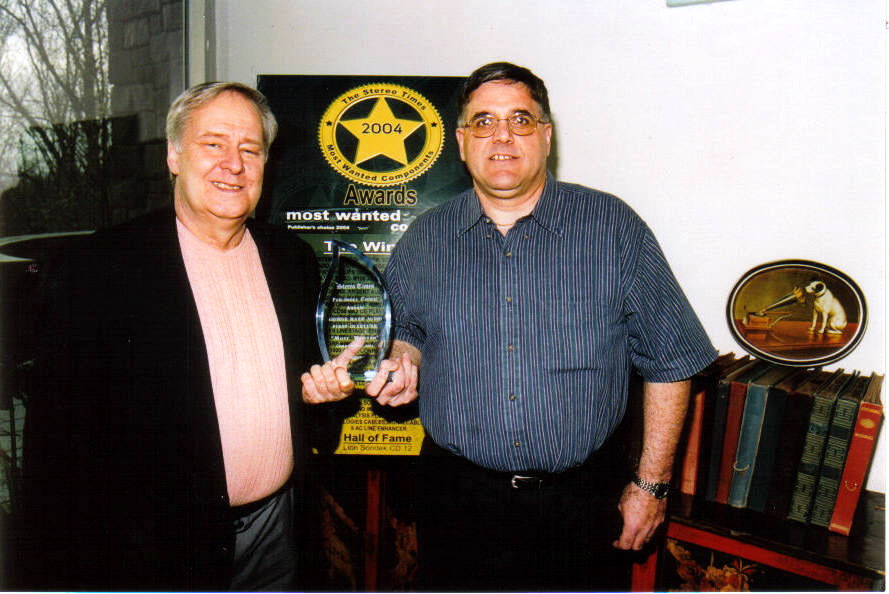
(Above: Posing proudly next to Most Wanted Component Award 2004are from left to right: George Bischoff and Mark Moschella)
I ran the First Overture around the clock for about two weeks before doing any serious listening. Finally, with a nice cup of Java in one hand and my remote control in the other, the time had arrived. CD after CD was placed into my transport and from the start it was obvious: the First Overture is of true reference caliber. As good as my Kora Hermes II. The First Overture took me to another level of listening quality, ease and that wonderful sense of enjoyment. At once, the presentation of the music took on a more realistic and natural sound. That’s a lot to say when you consider how much I loved my Kora Hermes.
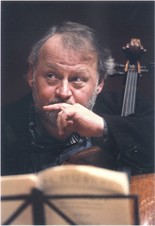 Listening to Haydn’s Cello Concerto in C, H. No.1 (Ph.Dig. 420 923-2), performed by Heinrich Schiff (right) and the maestro Sir Neville Marriner, conducting Academy of St. Martin-In The Fields-the First Overture sounded exceptionally lifelike. The sound possessed a certain magic that tube lovers can immediately identify with, neither fatigue nor aggressive sounding with a very sweet and extended treble. The First Overture compelled me to turn up the volume to hear the swell of this recording. Schiff took center stage, well in the front of the orchestra. The orchestra itself remained behind Schiff in realistic space amidst a very deep and wide soundstage. With the First Overture, the performers, the stage, the space, and the ambience were more distinct, giving a very realistic canvas to this recording.
Listening to Haydn’s Cello Concerto in C, H. No.1 (Ph.Dig. 420 923-2), performed by Heinrich Schiff (right) and the maestro Sir Neville Marriner, conducting Academy of St. Martin-In The Fields-the First Overture sounded exceptionally lifelike. The sound possessed a certain magic that tube lovers can immediately identify with, neither fatigue nor aggressive sounding with a very sweet and extended treble. The First Overture compelled me to turn up the volume to hear the swell of this recording. Schiff took center stage, well in the front of the orchestra. The orchestra itself remained behind Schiff in realistic space amidst a very deep and wide soundstage. With the First Overture, the performers, the stage, the space, and the ambience were more distinct, giving a very realistic canvas to this recording.
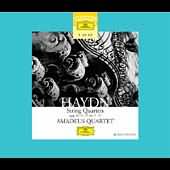 The First Overture sounds startlingly natural and its portrayal of individual images was just magnificent. Listening to one of my favorite chamber music pieces, Haydn‘sString Quartet in D major, op. 64 no. 5“The Lark” (DG 423 622-2) performed by Hagen Quartet, the First Overture’s rendering of the strings was so natural that the timbre of the individual instruments was presented in a way that I could only describe as magical. It was able to delineate with greater ease, each instrument’s harmonics, size, and shape. Subtle details such as pitch variation and bowing texture were apparent. Individual images were reproduced remarkably; the space, size and three-dimensionality were amazingly accurate. It gave me the sense that if I closed my eyes I could imagine, the Hagen Quartet in the room performing. The strings sounded like silk, never edgy nor harsh even when playing loud. Everything stayed in its place. I became deeply involved with the music and forgot about the electronics. Isn’t that what this hobby is all about?
The First Overture sounds startlingly natural and its portrayal of individual images was just magnificent. Listening to one of my favorite chamber music pieces, Haydn‘sString Quartet in D major, op. 64 no. 5“The Lark” (DG 423 622-2) performed by Hagen Quartet, the First Overture’s rendering of the strings was so natural that the timbre of the individual instruments was presented in a way that I could only describe as magical. It was able to delineate with greater ease, each instrument’s harmonics, size, and shape. Subtle details such as pitch variation and bowing texture were apparent. Individual images were reproduced remarkably; the space, size and three-dimensionality were amazingly accurate. It gave me the sense that if I closed my eyes I could imagine, the Hagen Quartet in the room performing. The strings sounded like silk, never edgy nor harsh even when playing loud. Everything stayed in its place. I became deeply involved with the music and forgot about the electronics. Isn’t that what this hobby is all about?
The First Overture’s effect on my system’s spatial performance was equally impressive. The soundstaging was superb, defined entirely by what was on the recording. The soundstages of the Edvard Grieg’s“Peer Gynt” op.23 Incidental Music to Ibsen’s Play (Ph 411 038-2) extended beyond the speakers’ outer edges and far beyond my listening room’s front wall, making the speakers vanish. The crescendos not only got louder, the sound gets bigger, filling the hall’s space completely without being aggressive and the picture never turned hard. The overall presentation was positively dazzling. It was clear that First Overture plays all types of music equally well, whether chamber, symphonic or jazz.
The First Overture communicated music’s inevitable flow with a relaxed precision that was seductive and absolutely addictive. The midrange is smooth, textured, colorful, and, on some recordings, it sounds lush and, yes, tube-like. 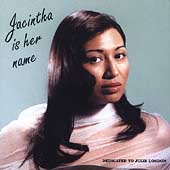 Would I call it tubey? Not really. Actually, there was no excess warmth, bloat, or reduction in frequency extremes. The First Overture’s ability to conjure the human voice is simply out of this world. On one of my favorite’s,I’m in the Mood for Love on “Jacintha Is Her Name” (GRV1014-2), there was a magic, richness and roundness in her vocals, that invited me in every time. Her presence factor was so incredible it was spooky. It made me believe that I actually could reach out and touch her.
Would I call it tubey? Not really. Actually, there was no excess warmth, bloat, or reduction in frequency extremes. The First Overture’s ability to conjure the human voice is simply out of this world. On one of my favorite’s,I’m in the Mood for Love on “Jacintha Is Her Name” (GRV1014-2), there was a magic, richness and roundness in her vocals, that invited me in every time. Her presence factor was so incredible it was spooky. It made me believe that I actually could reach out and touch her.
The George Mark Audio Technologies First Overture DAC Preamplifier is a superb DAC preamplifier- pretty much everything I’d want in a DAC and preamplifier. It did everything in an outstanding way. In some areas – naturalness, soundstage, midrange – it is the best DAC I’ve ever auditioned. Its pairing with my reference system was magical, never fatiguing to my ears; it was a beautiful musical experience. The only downside of this high-wire act is the need for extra rack space to support its monstrous power supply and the need for an additional AC cord. In my opinion, it’s well worth it because its asking price is much less than I expected considering what a great value this product is. Consider again, this is an all-tube preamp with a built in DAC that is every bit as good as some of the best I’ve heard.
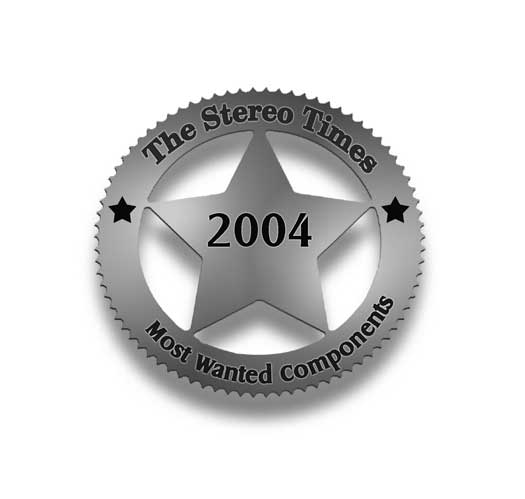 At $ 5,990.00, the First Overture DAC preamplifier is not cheap, but experiencing it in my reference system, I consider it to be very reasonably priced especially in today’s competitive market. In the end not only did I nominate it as my choice for Most Wanted Component 2004, I bought the review sample!
At $ 5,990.00, the First Overture DAC preamplifier is not cheap, but experiencing it in my reference system, I consider it to be very reasonably priced especially in today’s competitive market. In the end not only did I nominate it as my choice for Most Wanted Component 2004, I bought the review sample!
_____________
Specifications:
Digital Circuitry:
24 bit/192 kHz capability
THD+N (0dBFS, 1 kHz): 96dB
Dynamic Range: 106 dB
Signal to Noise ratio : -96dB
CD Decoding: 44.1 kHz
DVD Decoding: 96 kHZ
CD Up-sampling: 132.3 kHz
CD Network: 176.4 kHz (call for information)
DVD Network: 192 kHz (when available)
Vacuum Tube Analog Circuitry:
Maximum Gain: 20 dB
Maximum Output: 20 Volt
THD + IMD: 0.01%
S/N ratio better then 90 db
Dual-Mono circuitry, 3 separate power supplies
Two power cords are required
Outputs:
Balanced XLR Outputs
RCA SE Outputs
Inputs:
RCA Analog Inputs
Digital Inputs:
AES/EBU
Coaxial
Optical
Contact:
George mark audio technologies
P.O. Box 2986 Westfield, New Jersey, 07091-2986
Toll Free Phone: 877 272 1567
Fax: 908-314-0042
info@georgemarkaudio.com
www.georgemarkaudio.com
![]()
Don’t forget to bookmark us! (CTRL-SHFT-D)
Stereo Times Masthead
Publisher/Founder
Clement Perry
Editor
Dave Thomas
Senior Editors
Frank Alles, Mike Girardi, Russell Lichter, Terry London, Moreno Mitchell, Paul Szabady, Bill Wells, Mike Wright, and Stephen Yan,
Current Contributors
David Abramson, Tim Barrall, Dave Allison, Ron Cook, Lewis Dardick, John Hoffman, Dan Secula, Don Shaulis, Greg Simmons, Eric Teh, Greg Voth, Richard Willie, Ed Van Winkle, Rob Dockery, Richard Doran, and Daveed Turek
Site Management Clement Perry
Ad Designer: Martin Perry





Be the first to comment on: george mark audio technologies First Overture DAC/Preamp